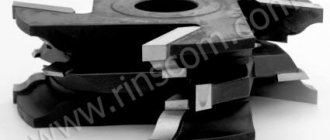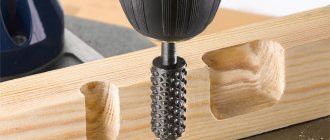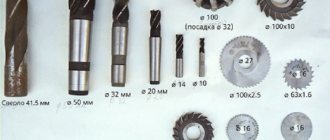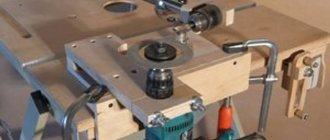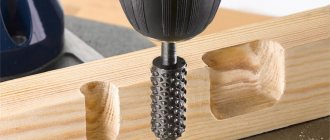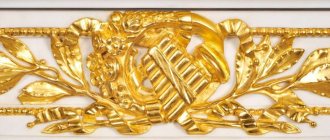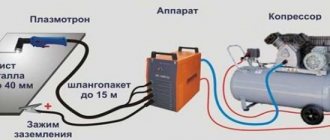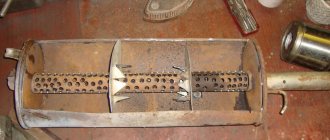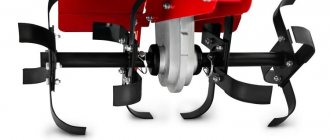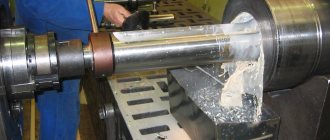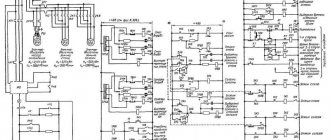What is it and what is it for?
The copying sleeve is a ring that slides along the edge of the template. As a result, the cutter exactly follows the specified contour and does not intersect the marking lines. It is impossible to cut a workpiece smoothly by guiding the tool manually, much less make several completely identical parts.
The copy sleeve consists of a ring and a flange. The axis of symmetry of the device coincides with the axis of rotation of the spindle. The flange is made according to the size of the hole in the supporting plane of the router, and is attached to it. When pressure is applied to the housing with the motor, the working part of the tool is lowered along the guides, perpendicular to the supporting sole.
The cutter ends up below the sole and cuts into the workpiece. The copying ring rests its side surface against the end of the template, preventing the tool from going beyond its boundaries. Using a stencil, you can cut out a design of any complexity onto a part. It is enough to go along the contour with a cutter, then clean the entire area of the understatement.
Milling cutters for hand router
Milling cutters are cutting tools that process and shape a surface. They consist of a cylindrical part, which is clamped by collets in the unit holder, and a cutting part. The cylindrical part can be of different diameters. Choose one that has a collet for which your device has. The shape and location of the knives of the cutting part determines the appearance that the wood receives after processing. Some cutters (for edges) have a stop roller. It specifies the distance from the cutting surface to the material being processed.
Working with a hand router on wood requires the presence of a certain number of cutters. This is a small part of what exists
Milling cutters are made from different metals and alloys. For processing soft wood - pine, spruce, etc. - use conventional nozzles (HSS), for hard woods - oak, beech and others - from hard alloys (HM).
Each cutter has a certain resource and maximum speed at which normal operation is ensured with minimal runout. You should not exceed the recommended speed - this may cause damage to the router. There is also no point in sharpening a cutter if it is dull. This is done using special equipment (costing about $1000), where you can set the required sharpening angle. Nothing good will come of it manually. So, dull ones are easier (and cheaper) to replace, since they cost relatively little.
Popular types
There are a number of types of router bits that are used most often.
- Edges. Serve for processing the side surfaces of workpieces. With their help, you can make smooth or shaped edges, you can form recesses and spikes for joining parts. It is this type of cutter that comes with a bearing at the end - it rests on the part, setting the distance from the edge of the workpiece to the cutter.
Some types of edge cutters - Grooved. They are used to form grooves and recesses of various shapes. They are: spiral (a) - mainly used to form technical grooves, for example, a tongue/groove connection;
- fillets (b, d) - for decorating the surface with grooves of different shapes, they can be round, V-shaped or figured;
- dovetail (c, d) - to form a groove in the form of a trapezoid; this groove is used for open and hidden connection of parts;
- shaped (d) - they are used to decorate the surface with grooves of complex shapes.
Groove cutters - for forming grooves anywhere on the part
There are simple cutters, formed from a single piece of metal, and there are typesetting ones. Stacked ones have a shank - a base, a certain set of different cutting planes, a set of washers of different thicknesses. From these parts you can independently form the required relief.
A set cutter is a set of several cutting surfaces and washers from which you can make a cutter of the required shape
These are the most popular types of cutters, but in fact there are a lot of them. In addition to the different diameters of the shanks, there are different diameters of the cutting surfaces, their height, the location of the knives relative to each other, etc. In general, for do-it-yourself milling, you usually need about five of the most common cutters. They are usually present constantly, and the rest are purchased for specific types of work.
How to make it yourself?
The strength and wear resistance of the metal of the copy ring determines how long the device will last. Power tool manufacturers make their bushings from tool steel. To connect the ring and flange, special welding equipment is used.
At home, you can make less durable, but cheaper devices for the router. To do this you will need a benchtop lathe.
Only a highly qualified specialist can weld together parts of such thickness. For amateurs, it is enough to place the flange on the glue and rivet the thin end of the ring.
How to use such a device for a router?
The stencil is applied to the workpiece according to the markings and fixed. A hole is made with a drill. A cutter is inserted into it and the contour is processed.
In everyday life, groove milling using a copy sleeve is most often used when installing doors. Craftsmen cut out grooves for handles and locks on site with high precision, and make lowerings for canopy slats.
In carpentry workshops, decorative furniture elements are cut out using a template. Using shaped cutters, a carpenter produces batches of parts with complex patterns. The copying sleeve makes it accessible and simple to select grooves and recesses of any configuration. It is enough to make the template correctly and adjust the processing depth.
Source
What is a copy sleeve used for?
It helps to confidently guide the cutting elements of the router along a complex trajectory, maintaining the distance between the cutter blade and the edge of the template. As a rule, it is used in conjunction with various templates and rules that should be followed along the edge of the part. The outer edges of this instrument necessarily extend beyond the sole of the instrument.
Copy bushings for router
Installation should be done using two mounting bolts. They are mounted in the threaded holes on the base of the router that are available there. There is a separate class of bushings; they are height adjustable. They must be used where a tight fit of the sleeve itself to the template or rule is required over an extremely large area. They are fixed with a clamping screw or screwed in from the bottom of the plate. The manufacturer makes the diameters of the guide surface of the bushing different in size and does this in order to be able to work with cutters of different diameters, as well as create combinations of cutters with bushings. The length of the segment limited by the edge of the template and the cut line is determined by the difference in the diameters of the guide plane of the copy sleeve and the cylinder. When working with a template, you should take this parameter into account. The length of the segment from the sleeve to the cutter is approximately 3–4 mm. This is done in order to ensure the free exit of chips arising during the work process. To protect the workpiece, it is important that the flange and heads of the bushing fastening screws do not extend beyond the plane of the milling machine base. The bushing flange must be flat and fit tightly into the groove intended for it. Before installing the bushing, this groove must be cleared of chips and resin. The thickness of the template plays an important role in the work process. At the same time, it should be such a thickness that the sleeve does not rest against the workpiece. This is necessary so that the protrusion does not spoil the part. With its help, you can mill liners, recesses, and also cut out various decorative elements.
Copy ring for Fiolent router
The copy ring is a round plate with a protruding shoulder that slides around the template when working. In this way, the required trajectory of movement of the cutting element of the milling cutter is ensured. The ring is attached with screws to the base of the milling machine. During operation, the ring protects the template from the cutting effects of the cutter teeth. The copy ring is characterized by such properties as strength, reliability, durability, and wear resistance.
On the Russian market you can purchase these Fiolent products at a low price - about 10–20 USD. e. Fiolent products are budget-friendly and designed for the mass segment of consumers.
Milling cutters for a manual wood router: design features
The range of cutters for woodworking on the shelves of Russian stores is quite wide. But if we talk about design, then on this basis we can distinguish three main types:
- Prefabricated cutter - This is a blank with cutting elements welded to it. The manufacturing technology of such nozzles is quite simple, which is the reason for their leadership in the number of sales - the bulk of nozzles sold are of this type.
This is what a prefabricated cutter looks like - the most common option on the market - Nozzles with replaceable cutting elements. These cutters have sharpened edges on both sides, which allows you to turn the attachment over if one side is dull and continue processing.
And this is a nozzle with replaceable cutting elements - Monolithic cutter It is a solid element, the edges of which are machined into the base. It is almost impossible to break such a cutter, but several sharpenings render it unusable.
It is almost impossible to break a monolithic cutter - they are the most durable
Do-it-yourself copying bushings for a router
In some cases, the manufacturer does not equip the milling machine with such an important tool. To make this necessary device yourself, you will need a washer made of duralumin or sheet metal, and a plumbing extension made of metal with a thread. The manufacturing process is as follows:
In this article, we tried to briefly highlight the key points regarding bushings, talked about the method of their manufacture, and talked a little about such a useful tool as a copying ring.
Source
Features of copy rings
Copy rings are a round plate that has a protruding shoulder.
When the equipment is operating, the collar slides around the template.
With the help of this component, the necessary trajectory of the cutter is ensured.
The mounting location for this device is the base of the router.
Various methods can be used to attach it.
Most often it is screwed into the hole with a thread.
Some copying rings are equipped with special antennae that are inserted into special holes when they are attached to the cutters. Copy rings can also be screwed on. Screws are most often used for this purpose.
When choosing this device, it is imperative to pay attention to its size. In terms of its diameter, it should match the diameter of the cutter as accurately as possible.
In this case, the selection of the ring is carried out in such a way that its diameter does not come into contact with the cutting parts of the cutter. To compensate for the diameters between the ring and the cutter, templates are selected so that they are smaller than the finished parts.
Varieties of attachments for working with templates
Regardless of which router you choose, using a specific router attachment is important.
Today there are quite a lot of such attachments. Therefore, in order to get a high-quality result, you need to think carefully about which one to choose for processing your parts.
There are several types of attachments that will help you make it easier to work on individual sections of a wooden piece. So, while cone cutters are capable of creating a certain angle in wood, disc cutters are an excellent choice for cutting parts at right angles. For roundings, molding type attachments are used. But rebated and profiled attachments are perfect for artistic finishing of wood parts.
There are also very complex parts. Here it is necessary to carry out milling over them in combination, using one or another type of cutter. In this case, even for the same area, several different nozzles can be used. Usually such complex works have a certain artistic value. At the same time, if you do not have the opportunity to use different attachments, you can limit yourself to one main one. But in this case, the work will be long and will require much more painstaking work from you.
So, the main points on working with templates for wood milling have been discussed. If you take into account the above tips and sequence, carry out milling carefully and don’t rush anywhere, you can achieve good results and get beautiful, identical parts.
Buying a bushing.
The bushings are usually made of brass or steel. Honestly, I don't think one material has a huge advantage over the other. A router with a brass guide bushing is less likely to damage the router bit. Let's take a closer look at the type of brass bushing. Many steel guide bushings are stamped and do not have much precision, so they can result in inaccurate milling. Brass bushings can be shifted in order to correctly position themselves at the base of the router and coordinate the position of the bushing with the center of the cutter. This is important and always gives accurate results; such a bushing solves the problem of centering on the base of any router model.
A router with a guide bushing is required in templates where dovetail cutters are used. The jig kit often already includes the correct guide sleeve for use.
Often, the manufacturer of template rulers such as dovetail grooves will do the work of selecting the correct ruler and guide sleeve (photo on the left). If you want to use your own tools that use bushings, then match the two diameters, cutters and bushings before using them. As a rule, when routing for the first time, I choose a slightly smaller cutter. This provides the necessary margin, for example inside the groove, during preliminary milling. If you use a router as a slotting device, then you must take into account the size of the offset on both sides of the groove; when milling one edge, you need to take into account the offset on only one side. will always open up new possibilities and I think you'll agree that bushing guides are a great way to do that. They just require a little skill in setting up to make precise connections.
Since the milling machine is a widely used tool among amateur and professional carpenters, additional tools for it, such as copying sleeves and rings, will be indispensable when working.
In this article we will tell you how to make a copying ring for a router yourself, we will figure out what the copying sleeves are for, and how to handle them at work.
Types of equipment by profile
So, before us is a box full of various wood cutters. How to figure out what each one is suitable for? Over time, you will learn to imagine the profile that the equipment will allow you to achieve. Now let's define its main types.
Grooved
Read also: Headdress for a fur coat (93 photos)
The most popular type of cutters: they are used to make connections between parts. They have different diameters. You can select equipment of the appropriate size for each groove or take a cutting tool of a smaller diameter.
- Fillet - make it possible to make, in addition to straight grooves and folds, semicircular grooves or grooves; These include a V-shaped cutter designed for making decorative carvings.
- Structural grooves - for example, dovetail, T-shaped, are available for certain types of connections.
- Splice cutters - necessary for making either long parts or wide panels.
- Shaped grooves - give the treated surface of the recess a special look.
Edge
Milling cutters with guide bearings differ in operation. The guide bearing allows edge processing to be carried out without any additional tools. The equipment rests on it when it moves along the workpiece. The only requirement for its use is that the edge of the workpiece must be vertical and even. Equipment without a bearing - driven by a stop, is used for a larger number of operations. Can only be used in conjunction with a rip fence, guide bush or compass.
- Straight edges (edging) - used for milling according to a template, as well as for cutting laminate and veneer.
- Conical - make it possible to make an edge at an angle of 45º.
- Moulded – using equipment you can make the edge round.
- Decorative - each shaped edge cutter gives the surface a special shape.
- Disc - make it possible to make a groove along the length of the edge or select folds.
Profile
Designed for decorative milling. Horizontal figurine cutters are of greatest interest, as they are used in the manufacture of panels.
Application of the ring
When using a milling ring, it is possible to mill according to a template. In this case, the same pattern is copied onto the workpiece.
Performing certain jobs requires not only carpentry skills, but also the ability to handle tools. For example, in order to install door hinges, you need to spend a lot of time.
To reduce it, a hand cutter is used, into which a copying ring is pre-installed. With its help, you can produce the most accurate milling of small parts.
The copying ring is designed to protect the template from the cutter. When the tool operates, a flange slides along the edge of the template.
It should have an optimal size that will allow the cutter to rotate freely during operation. That is why the distance between the cutter and this device is taken into account.
In order to find out the optimal distance between this device and the cutter, it is necessary to subtract the diameter of the device from the diameter of the cutter. The resulting value is divided by two.
This number will become the optimal distance between the cutter and this device. If templates are made that have numbers, then this requires increasing the distance between the cutter, the movement of which is carried out inside the template, and this device. In this case, the template itself should be a little larger.
In order to determine the movement characteristics of the cutter, a distance is added between it and this device. For example, if you use a 12 mm cutter and a copy ring whose diameter is 16 mm, then using this tool you can attach flush hinges for a folding table, the size of which is 30x71 mm.
Once the copy ring is installed, it should move five millimeters under the base.
To make a template, you must use a board whose thickness is at least six centimeters. You need to cut off a small piece from it.
Its size must fully correspond to the size of the tool, which will provide high-quality support. On one side, it is necessary to mark the place where the hinges will be attached.
After this, the distance between the cutter and the copy ring is added in accordance with the above formula.
Calculating the distance between this device and the cutter is quite simple. It can be produced independently, even by a master without relevant experience.
If the copying rings for the cutter are selected correctly, this will ensure the highest quality work.
Edge cutters
In most cases, edge cutters have a thrust bearing. Thanks to it, it becomes possible to guide the tool along the template, processing the edges and edges of the workpiece.
Half-rod
The tool creates semicircular protrusions on the edges of workpieces.
If you use a half-rod cutter in combination with a molding or fillet cutter, you can make hinged joints. Half-rod tools are also used to produce round rods. In this case, the workpiece is processed on both sides.
Curly
These shaped cutters are also called multi-profile cutters. Depending on the tasks, the master can use part of the equipment profile or use it completely. In the second case, you will need to install the tool in a unit that has a power of at least 1600 W.
Fillet
Designed to give the workpiece ribs an internal radius or to make grooves with a circular cross-section.
Fillet cutters are equipped with one or two bearings, eliminating tool distortion.
Conical
Using cone cutters you can:
- chamfer the edge of the workpiece;
- decorate the edge of the tabletop;
- create an angular cut on the edges of the workpiece before gluing them (polygonal-shaped products can be obtained).
Also included in this category is an edge cutter with a blade angle of 45 degrees.
Folded
Used for cutting quarters and grooves of rectangular section. Thanks to the thrust bearing, the rebate cutter can be used on both straight and curved workpieces.
To adjust the groove depth, thrust bearings of different diameters are used.
The slotted disc cutter also falls into this category. With its help, a groove is cut in the workpiece for installing a T-shaped PVC edge.
Mouldings
Moulder cutters allow you to obtain an arched, straight, or shaped edge on a workpiece. Working with any part of the same equipment, you can:
- round the edge of the part;
- get a rebated edge;
- make a semi-rod protrusion;
- get edge with sponge;
- make decorative processing of the ribs, for example, making window frames.
You can also use molding cutters to create complex shaped ornaments on the edges and ends of a wooden part.
The equipment in this series can also be double, as shown in the following figure.
On a double cutter, the distance between the elements can be changed in accordance with the thickness of the workpiece. Thanks to two elements, the workpiece is processed in one pass, simultaneously on both sides.
Direct
A straight edge (overrunning or end) cutter is used for finishing the ends of a workpiece or creating an ideal 90 angle between the face of a part and its edge (end). The bearing can be installed at the top or bottom of the tool.
With the lower position of the bearing, the template is fixed under the workpiece, and with the upper position - above the workpiece.
In addition to the facing function, the equipment with the upper bearing can be used as a groove tool and cut a rectangular groove on the workpiece face, of course, using a template of a certain height. The diameter of the bearing is usually equal to the diameter of the tool, meaning it is flush with the cutting edge. But in some cases it is changed to a smaller or larger diameter in order to expand the capabilities of the equipment.
Milling cutter “corn”
The corn cutter is also an edging cutter. Its main purpose is to grind and align the edges of the workpiece according to the template. Thanks to the special arrangement of the knives (in a spiral), easy chip removal and smooth operation of the tool are ensured.
Do-it-yourself copying bushings for a router
In some cases, the manufacturer does not equip the milling machine with such an important tool. To make this necessary device yourself, you will need a washer made of duralumin or sheet metal, and a plumbing extension made of metal with a thread. The manufacturing process is as follows:
In this article, we tried to briefly highlight the key points regarding bushings, talked about the method of their manufacture, and talked a little about such a useful tool as a copying ring.
Ring technique
Copy rings included in the set
The operation of this device is quite simple.
When moving the router along the template, it is possible to obtain a pattern that fully corresponds to this template.
Using this method, you can easily make an eye-catching door sign.
Most often, this method is used when there is a need to install flush door hinges.
In this case, you have the opportunity to produce the template yourself. Several grooves are milled along it, into which hinges will later be installed.
Making a template is a fairly lengthy process. Despite this, the production of the grooves themselves will be carried out within a few seconds.
Very often, a ready-made template is purchased for milling. It must be clamped with clamps.
You need to insert the flange of this device into it, and then just turn on the router. Next, the cutter is placed into the part and the router is moved in accordance with the shape of the template.
Milling of parts using a template is carried out using a fairly simple technology. When milling, the template imprint is not made to the full thickness.
In this case, there is a small distance between such devices as the edge of the template and the milled groove.
In order to eliminate this defect, it is necessary to attach the loop in the appropriate place and circle it with a pencil. It is necessary to determine the distance between the cutter and this device in accordance with the formula described above.
Next, the template is cut out. To sand its edge, you need to use fine sandpaper. Milling should be done in two stages on both sides of the loop.
It is also necessary to cut out recesses for the hinge pins. This will ensure that you can get the same level between the surface of the material and the loops.
Copy rings for a router, a video about which is presented below, are an ideal option for obtaining the most accurate workpieces.
Edge cutters for wood
Variety of edge cutters
Edge tools are used to produce various types of edges and recesses. Wood products can be processed using a manual router with edge cutters and fully processed. The edge type is the most common in use and has many modifications:
- Profile sets process parts in such a way as to give the required shape to the edges.
- With moulders, it is possible to round the edge of a part by a quarter of a circle.
- Conical ones remove a chamfer, the angle of which is often 45 degrees.
- Disc ones are used for making chamfers in parts, making subsequent connections possible.
- Folded ones process the part from the edge, leaving a quarter of the height.
- Fillets are necessary for making a groove, which is drawn into a quarter circle.
Wood edge cutters used for hand routers are often equipped with a bearing, the function of which is to limit the depth of processing required. The overhang of adjustment of the processing area is made by adjustment on the tool itself. Machining large parts requires many attempts. A hand router is used to work on wood in several stages until the thrust bearing begins to operate.
Guide rail
The guide rail, like the rip fence, ensures the linear movement of the router relative to the base surface during wood processing. Meanwhile, unlike a parallel stop, such a guide for a router can be located at any angle to the edge of the workpiece. Thus, the guide rail can provide the ability to accurately move the router during wood processing in almost any direction in the horizontal plane. A guide rail equipped with additional structural elements is also useful when milling holes located in wood at a certain pitch.
Fixation of the guide bar on the work table or workpiece is ensured by special clamps. If the basic configuration of the device does not include such clamps, ordinary clamps will be suitable for these purposes. Some models of guide bars can be equipped with a special adapter, which is often called a shoe. The adapter, connected to the base of the router via two rods, slides along the profile of the tire during processing and thus ensures the movement of the working head of the router in a given direction.
Making a groove with a router using a guide rail
A milling device such as a guide rail is best used in conjunction with routers whose support platform is equipped with height-adjustable legs. This is explained as follows. In cases where the supporting surfaces of the router and the tire are in different horizontal planes, which can happen when the device is too close to the wood workpiece being processed, the adjustable legs of the tool make it possible to eliminate such a discrepancy.
Guide devices for equipping a router, which, despite the simplicity of their design, will be highly efficient in use, can be made with your own hands without much difficulty. The simplest of such devices can be made from a long wooden block, which is secured to the workpiece using clamps. To make this device even more convenient, you can supplement it with side stops. If you place and fix a block simultaneously on two (or even more) pieces of wood, you can mill a groove on their surface in one pass.
Milling along a wooden plank fixed to a workpiece
The main disadvantage that distinguishes the device of the above-described design is that it is not easy to accurately fix the block relative to the line of the future cut. The guide devices of the two designs proposed below do not have such a disadvantage.
The first of these devices is a device made of interconnected boards and plywood sheets. To ensure alignment of this device with respect to the edge of the groove being made, the following conditions must be met: the distance from the edge of the stop to the edge of the plywood (base) must exactly correspond to the distance at which the tool used is located from the extreme point of the router base. The device of the proposed design is used if the tree is processed with cutters of the same diameter.
Device for making grooves with a router
For milling operations performed with tools of different diameters, it is advisable to use devices of a different design. The peculiarity of the latter is that when using them, the router comes into contact with the stop with the entire sole, and not just its middle part. The design of such a stop includes a folding board on hinges, which ensures the correct spatial position of the device in relation to the surface of the wood product being processed. The purpose of this board is to ensure that the stop is fixed in the required position. After this procedure is completed, the board folds back and thereby frees up space for the working head of the milling cutter.
Device with folding bar
When making such a device for a router with your own hands, you should keep in mind that the distance from the center of the tool used to the extreme point of the base of the router must correspond to the width of the folding board and the gap between the board and the stop, if it is provided in the design of the device. If in the manufacture of this device you focused only on the edge of the cutter and the edge of the groove that needs to be formed with its help, such a device can only be used with cutters of the same diameter.
Often, grooves in wood blanks have to be milled across the fibers of the material, which leads to the formation of scoring marks. The amount of scoring can be reduced by devices that, by pressing the fibers in the place where the cutter comes out, do not allow them to break off from the surface of the wood being processed. The design of one of these devices consists of two boards, which are connected to each other with screws at an angle of 90°. The width of the groove made in such a device must match the width of the recess created in the wood product, for which cutters of different diameters are used on different sides of the stop.
Another milling device, the design of which consists of two L-shaped elements, fixed to the wood product being processed with clamps, is required for milling open grooves and ensures a minimum amount of scoring during processing.
Functional cutter sets
You can often find functional sets on sale that consist of two or more elements. This set includes accessories and attachments for a wood router. The main purpose of such kits is to process two or more parts to obtain similar connections. For example, there is a set of 2 cutters, one of which forms an edge inside the product, and the second allows you to make a groove part.
There are universal options that, thanks to their design, can be used for various purposes. The collapsible part involves replacing the cutter blades, after which work with wood is carried out.
It is worth noting that the presence of a table for storing all types of equipment accessories will reduce the time for the actions performed, and it is also possible to build something like a milling machine. By installing movable stops on the table, the master expands the range of possibilities of the tool for woodworking.
Features of the production of devices
A copying ring is a universal device that is widely used for milling a variety of parts with a high level of accuracy. These products are characterized by:
Maximum precision in the production of workpieces when using copying rings is achieved thanks to their correct geometry. Copying rings are characterized by the presence of several standard sizes, which allows them to be used for various tools.
The production of these devices is carried out using universal technology, which ensures their excellent performance. For the manufacture of copy rings, heavy-duty metal is used, which limits the possibility of their breakage during operation.
Thanks to the presence of a special coating on the products, they are resistant to corrosion and other negative environmental influences.
Thanks to the ergonomic shape of this device, a high level of convenience is ensured during its installation on the cutter. These devices are quite small parts, which provides convenience during their storage and movement.
The copying ring is an integral part of the milling machine, with the help of which the most accurate work is carried out. For this purpose, you just need to select the right ring.
Milling and its features
Today, many people, when installing furniture, carrying out repairs, etc. need metal or wood processing. Milling is most often used for this purpose.
This is a process in which metal is cut. For this purpose it is necessary to use a rotating cutting tool.
Simultaneous feeding of the workpiece is carried out according to the linear principle. Removal of material from the workpiece is carried out using a cutter, onto which a copying ring is placed, to a certain depth.
When processing material, the work of the cutter can be carried out from the periphery or from the end. When the tool operates, the cutter rotates.
The copy ring rotates with it. The tool has peripheral and end cutting edges of the teeth, with the help of which milling is carried out. In this case, there is an increase in the cut thickness towards the center and a decrease in it upon contact between the cutter and the workpiece.
The copy ring is an integral part of milling equipment. With its help, templates are read, which greatly facilitates the process of working with a milling machine. Installation of this device on the router is carried out without the use of special tools, which allows anyone to easily perform this action.
In appearance, the copy ring resembles a round plate, which is characterized by the presence of a protruding collar. The rings are made of steel, which ensures long-term operation.
The copy ring is characterized by the presence of an internal and external diameter. The internal diameter of this device is a fairly important aspect, since this indicator is used to select it for a specific cutter.
With the help of copy rings, a milling machine not only produces blanks, but also rounds corners. To perform this action, it is necessary to use copying rings that match the cutter in diameter as closely as possible.
In order to make the procedure as simple as possible, you need to use a template. Quite often, an adjustable template is used.
With the help of copying rings, working with the milling machine is greatly simplified for the operator.
Despite the fact that these devices have relatively small dimensions and are almost invisible in a milling machine, they allow you to produce a variety of workpieces with maximum precision.
Milling cutters for hand milling tools
A milling cutter is a cutting tool that can have an intricately shaped cutting edge. As a rule, all cutters are designed for rotational movements and therefore have a cylindrical shape. The shank of the cutter, which is clamped in the collet, has the same shape. Some cutters are equipped with a thrust roller, so that the distance between the cutting surface and the material being processed remains constant.
Milling cutters are made only from high-quality metals and their alloys. If you need to process soft wood, then HSS cutters will do, and if you need to process hard wood, then it is better to use cutters made of harder HM alloys.
Each cutter has its own technical characteristics, which provide it with high-quality and long-lasting performance. The main indicator is the maximum speed of its rotation, which should never be overestimated, otherwise its breakdown is inevitable. If the cutter is dull, you should not try to sharpen it yourself. Sharpening of cutters is carried out using special, expensive equipment. After all, you need not only to sharpen the cutter, but also to maintain its shape, which is no less important. Therefore, if for some reason the cutter becomes dull, it will be cheaper to buy a new one.
The most popular cutters
There are cutters that are used in work more often than others. For example:
- Edge cutters. With their help, the end surfaces of wooden blanks are cultivated. In addition to the curved edge, they can be used to form spikes or grooves to connect parts. Such cutters may have a bearing at the end that rests on the part, setting the processing distance.
Some types of edge cutters. - Groove cutters. These are cutters for forming grooves of various shapes. They, in turn, are:
- Spiral (a) - used to form technical grooves, such as tongue/groove.
- Fillet (b, d) - used for finishing surfaces in the form of grooves of various shapes and depths. They can be rounded, V-shaped or curly.
- Dovetail (c, d) - used to create a specially shaped groove intended for hidden or open connection of wooden parts.
- Shaped (d) - intended for decorating wooden surfaces. As a rule, they help create free-form grooves.
Groove molds are designed to create recesses in any location on the workpiece.
There are cutters that are simple, monolithic, made from a single piece of metal, and there are typesetters. Set cutters consist of a shank, which serves as the basis for a set of cutting elements. By selecting cutting planes and installing them on the shank, using washers of various thicknesses, you can form an arbitrary relief on the surface of the workpiece.
A set cutter is a set of cutting surfaces and washers that allows you to assemble a cutter of the desired shape.
In fact, there are a lot of cutters and this is only a small fraction of what is produced. All cutters differ in the diameter of the shank, the diameter of the cutting surfaces, their height, the location of the knives, etc. As for manual milling equipment, it is enough to have a set of five of the most common cutters. If necessary, you can purchase them at any time.
Exercise
It is necessary to attach flush hinges measuring 30 x 71 mm for the folding table. We will use a 12 mm groove cutter and a copying ring with a diameter of 16 mm. After installation, the copy ring is shifted 5 mm under the base. The template is made from a board with a thickness of at least 6 mm. We saw off a piece of board large enough to provide support for the entire base. On one side, mark the place for the loops and add the distance between the copy ring and the cutter: 16 mm - 12 mm = 4 mm, which we divide in half. That is, you need to add 2 mm.
Source
Criteria for choosing a cutting tool for wood
When choosing wood cutters for a manual unit, you should pay attention to the following equipment parameters.
Shank diameter and size
It should be taken into account that some foreign manufacturers of cutters may indicate the shank diameter in inches. In most cases, if a collet clamp is installed on the unit, then there will be no problems with installing the equipment, of course, provided that the diameter of the collet matches the diameter of the shank.
It is important to know that the collet of a hand-held unit is not a drill chuck into which you can clamp tools of different diameters . The inner diameter of the collet must strictly correspond to the diameter of the tool shank. Difficulties may arise if you buy equipment with a 1/2ʺ (12.7 mm) shank and try to insert it into a collet with a 12 mm diameter. At the same time, a shank with a diameter of 6 mm will be clamped in a collet at 1.4 inches (6.35 mm) without any problems.
Before purchasing a cutter, especially an expensive one, read the instructions for the unit and find out which collet is installed on it.
The length of the tool shank is also of great importance. Not all of them have elongated shanks, and sometimes their size is not enough to use the tool, for example, when expanding deep grooves. Also, long shanks of the equipment may be needed when securing the unit under the table. In this case, it is customary to use a cutter extension, which is clamped in the collet of the unit.
Blade material
This is an important criterion when choosing equipment. The product can be made of high-speed steel (HSS) or carbide (HM). High-speed steel blades easily cope with soft wood of low density. But these cutters are not suitable for processing hard wood. In this case, they can be replaced with equipment with carbide blades.
Location of cutting elements
The blades on the tool can be positioned vertically, that is, parallel to the axis of the shank, or at a certain angle to it. Vertically positioned blades work like a plane and cut wood more than they cut it. Therefore, if the blades are a little dull, they will leave marks on the surface they treated, which will have to be sanded.
Blades located at an angle to the axis of the tool work much cleaner and do not chip.
